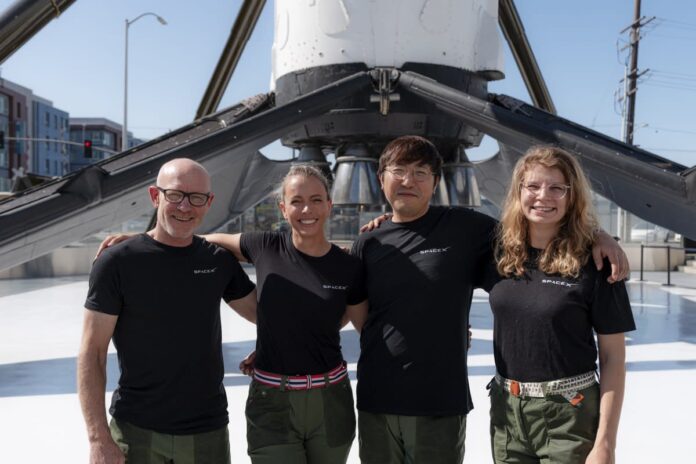Chun Wang, the co-founder of Bitcoin mining pool f2pool and a well-known figure in the Bitcoin community, is set to command SpaceX’s first human spaceflight mission to explore Earth’s polar regions from orbit. Wang, who began mining Bitcoin back in 2011, said he has been eagerly preparing for this mission for the past 2.5 years and has been involved in every aspect of the mission, from the initial proposal and planning to the trajectory design and crew selection.
“Named in honor of the ship that helped explorers first reach Earth’s Arctic and Antarctic regions, Fram2 will be commanded by Chun Wang, an entrepreneur and adventurer from Malta,” SpaceX announced. “Wang aims to use the mission to highlight the crew’s explorational spirit, bring a sense of wonder and curiosity to the larger public, and highlight how technology can help push the boundaries of exploration of Earth and through the mission’s research.”
Fram2 will become the first human spaceflight mission to fly over and explore the Earth’s polar regions from orbit. Learn more about the @framonauts mission here → https://t.co/3InB5ybsIx pic.twitter.com/rZ2PCw0GlX
— SpaceX (@SpaceX) August 12, 2024
“This mission represents a new chapter in space exploration,” said Wang. “I’ve read many sci-fi stories about the first human missions to Mars, usually led by NASA or some fictional government. Rarely does anyone dare to imagine such a mission may be carried out privately. But now, I increasingly believe that someday we will reach Mars — and it may be a person, or a company, not a nation, who gets there.”
Please allow me to quote Steve Jobs’s original iPhone announcement in 2007: “This is a day I’ve been looking forward to for two-and-a-half years. Every once in a while, a revolutionary product comes along that changes everything.”
Yes, I’ve been looking forward to this mission…
— Chun (@satofishi) August 13, 2024
Joining Wang on this mission is an international team of adventurers, including Norway’s Jannicke Mikkelsen, Australia’s Eric Philips, and Germany’s Rabea Rogge. Over the course of 3 to 5 days, the crew will observe the polar regions from Dragon’s cupola at an altitude of 425 to 450 km. They will study phenomena such as auroras and unusual light emissions, known as STEVE (Strong Thermal Emission Velocity Enhancement), and conduct a variety of research to better understand the effects of spaceflight on the human body, to gain insights into space physics and atmospheric science.
Credit: Source link






















 Bitcoin
Bitcoin  Ethereum
Ethereum  XRP
XRP  Tether
Tether  Solana
Solana  USDC
USDC  Dogecoin
Dogecoin  Cardano
Cardano  Lido Staked Ether
Lido Staked Ether  TRON
TRON  Wrapped Bitcoin
Wrapped Bitcoin  Wrapped stETH
Wrapped stETH  Chainlink
Chainlink  Avalanche
Avalanche  Sui
Sui  Stellar
Stellar  Litecoin
Litecoin  Toncoin
Toncoin  Shiba Inu
Shiba Inu  Hedera
Hedera  LEO Token
LEO Token  USDS
USDS  Hyperliquid
Hyperliquid  Polkadot
Polkadot  WETH
WETH  MANTRA
MANTRA  Bitcoin Cash
Bitcoin Cash  Ethena USDe
Ethena USDe  Bitget Token
Bitget Token  Wrapped eETH
Wrapped eETH  Uniswap
Uniswap  Monero
Monero  NEAR Protocol
NEAR Protocol  Pepe
Pepe  WhiteBIT Coin
WhiteBIT Coin  Aave
Aave  Bittensor
Bittensor  Ondo
Ondo  Aptos
Aptos  Internet Computer
Internet Computer  Dai
Dai  Official Trump
Official Trump  Ethereum Classic
Ethereum Classic  Mantle
Mantle  Tokenize Xchange
Tokenize Xchange  OKB
OKB  Gate
Gate  sUSDS
sUSDS  Coinbase Wrapped BTC
Coinbase Wrapped BTC 
